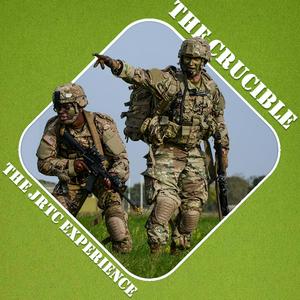110 S05 Ep 06 – Triage Under Fire: What Leaders Must Know About Prolonged Casualty Care, Part 1 of 2
The Joint Readiness Training Center is pleased to present the one-hundredth-and-tenth episode to air on ‘The Crucible - The JRTC Experience.’ Hosted by the Senior Medical Operations Officer Observer-Coach-Trainer for the Task Force Sustainment (BSB / CSSB), CPT Victor Velez on behalf of the Commander of Ops Group (COG). Today’s guests are subject matter experts in each of their warfighting fields, MAJ Jon Austin, SFC Scott Gallagher, 1LT Andy Cornelison, and LTC Max Ferguson. MAJ Austin is an armor officer from the Close Combat Lethality Task Force at the Maneuver Center of Excellence. SFC Gallagher is the former senior medic for 2-14 IN BN and is currently the Senior Enlisted Medical Advisor OCT for TF Sustainment (BSB / CSSB). 1LT Cornelson is a former Army Special Forces medic and is now the Physician’s Assistant for 2-14 Infantry BN, “Golden Dragons” of 2nd IBCT, 10th Mountain Division. LTC Max Ferguson is the former BN Commander for 2-14 IN BN and is now the G-3 Operations Officer for 10th Mountain DIV as well as serving as the J-3 for the JTF Southern Border.
The 2nd Infantry Brigade Combat Team, 10th Mountain Division, known by its Hollywood call-sign “Commando Brigade”, is a light infantry unit headquartered at Fort Drum, New York. Carrying the proud motto “Courage and Honor,” the brigade traces its lineage to the 10th Mountain Division’s storied World War II legacy in the mountains of Italy, where it earned distinction for its rugged combat effectiveness in extreme terrain. Reactivated in the post-Vietnam era, 2nd IBCT has since deployed multiple times in support of operations in Iraq and Afghanistan, exemplifying rapid deployment capability, adaptability, and lethality. Today, the Commando Brigade remains a cornerstone of the Army’s light infantry force, specializing in mountain and cold-weather operations while preparing for large scale combat operations across multiple domains.
The “golden hour” concept from the Global War on Terror era is being expanded in LSCO to account for prolonged casualty care under contested evacuation timelines. Whole blood and walking blood banks extend treatment coverage, creating larger windows for evacuation to the next level of care. While long practiced within Army Special Operations Forces (ARSOF), this marks the first employment of the concept by a conventional unit in recent history.
This episode of The Crucible podcast explores the evolving challenges and adaptations required for effective medical operations in LSCO. With evacuation timelines stretching well beyond the traditional “golden hour,” the discussion centers on how leaders must anticipate prolonged casualty care in contested environments. Panelists emphasized that bleeding remains the leading cause of battlefield death, and maneuver elements—not just medics—must assume responsibility for initiating lifesaving interventions at the point of injury. A key enabler discussed is the implementation of walking blood banks using pre-screened low-titer O donors to provide whole-blood transfusions far forward, drastically extending survivability in austere environments where surgical care is delayed or inaccessible.
The conversation also dives into the training implications for units preparing to conduct prolonged care. Leaders must invest time and energy into building whole-blood programs, standardizing procedures across echelons, and ensuring both medics and maneuver elements are prepared to manage triage, resource allocation, and life-saving interventions. Emphasis was placed on incorporating these efforts well before deployment—ideally as part of the training glidepath and Soldier Readiness Processing process—and enabling unit-level adjudication through validated kits and simplified protocols. The Joint Trauma System guidelines, Ranger Regiment best practices, and Marine Corps programs like Valkyrie were all cited as models for force-wide adoption. This episode represents a critical push toward institutionalizing practical solutions to the hard realities of LSCO casualty care.
Part of S05 “Beans, Bullets, Band-Aids, Batteries, Water, & Fuel” series.
For additional information and insights from this episode, please check-out our Instagram page @the_jrtc_crucible_podcast
Be sure to follow us on social media to keep up with the latest warfighting TTPs learned through the crucible that is the Joint Readiness Training Center.
Follow us by going to: https://linktr.ee/jrtc and then selecting your preferred podcast format.
Again, we’d like to thank our guests for participating. Don’t forget to like, subscribe, and review us wherever you listen or watch your podcasts — and be sure to stay tuned for more in the near future.
“The Crucible – The JRTC Experience” is a product of the Joint Readiness Training Center.


